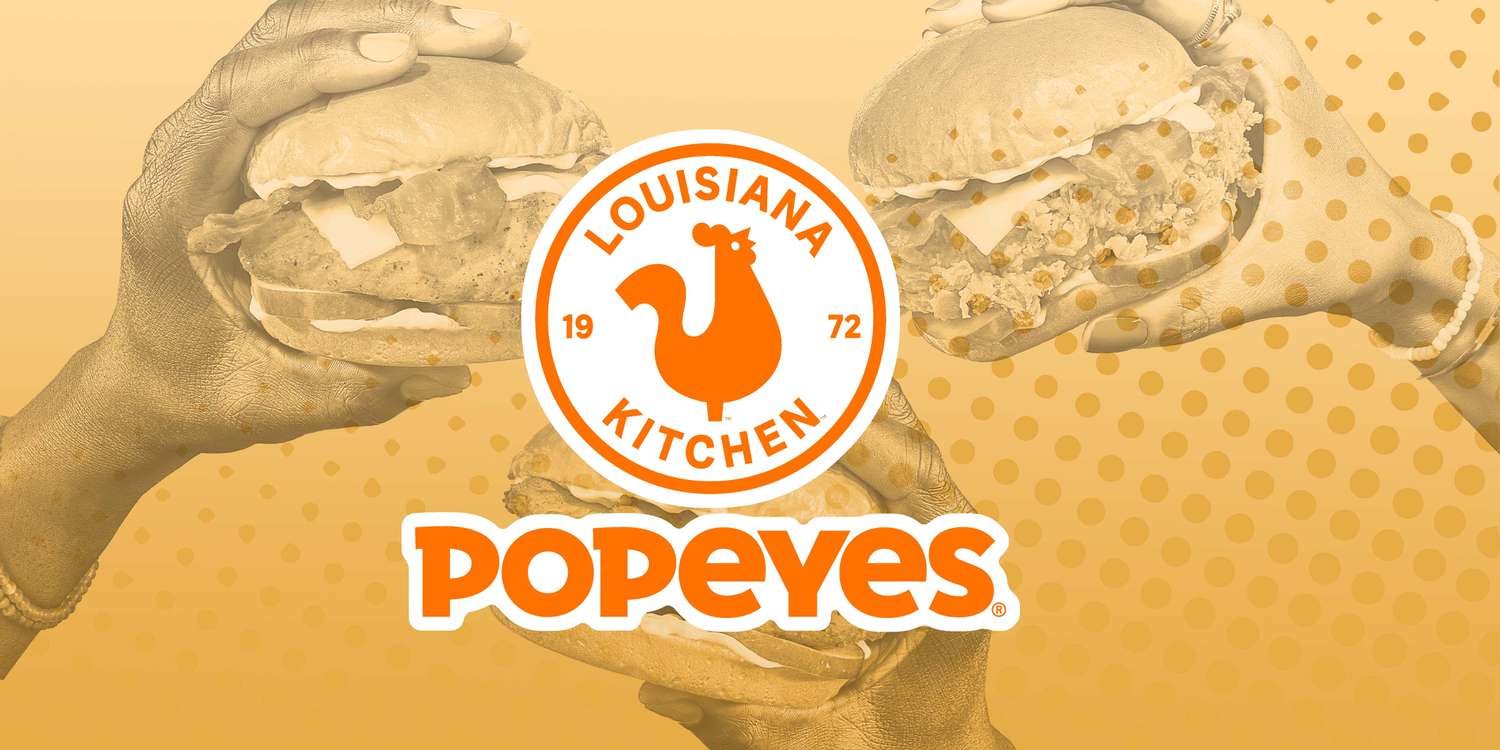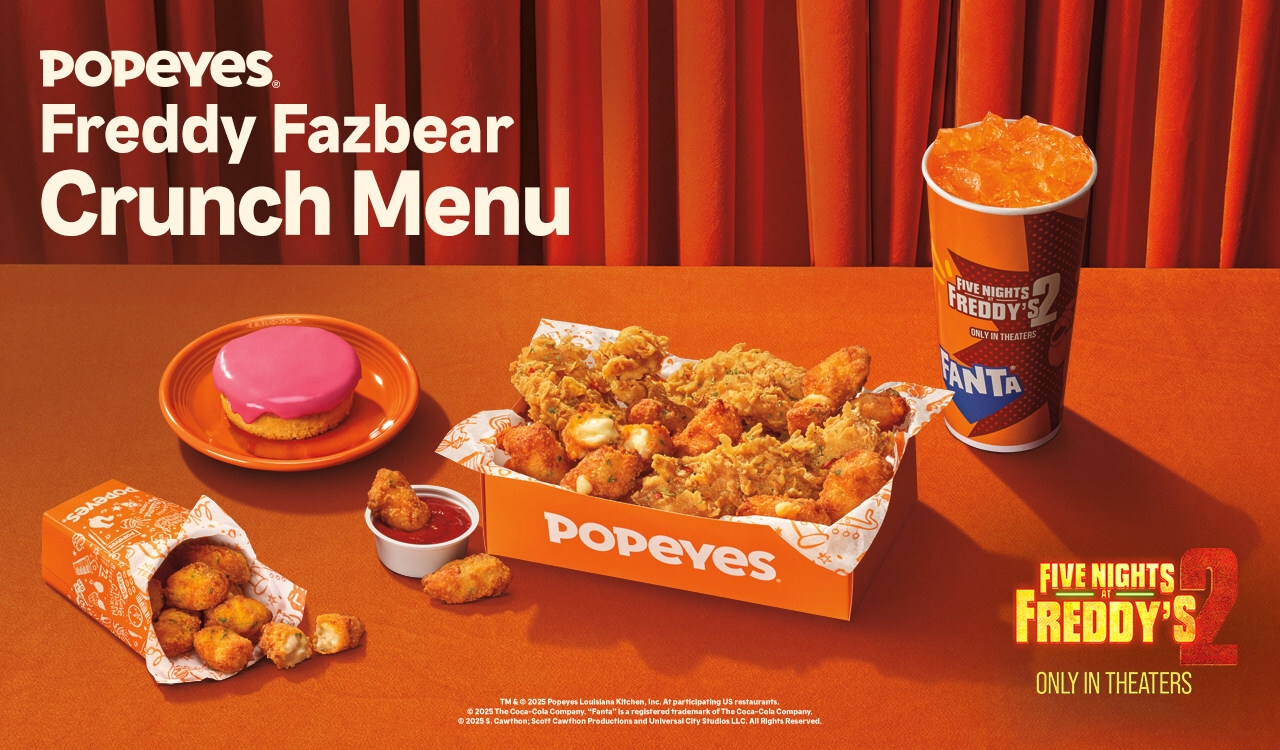The fast-food landscape is no stranger to marketing stunts and celebrity endorsements, but every so often, a collaboration emerges that transcends mere promotion, becoming a cultural event in itself. Such is the case with Popeyes’ latest audacious move, diving headfirst into the eerie, animatronic-infested world of Blumhouse’s “Five Nights at Freddy’s 2” with its new, limited-time “Freddy Fazbear Crunch Menu.” This isn’t just about selling fried chicken; it’s about tapping into a fervent fanbase, leveraging a blockbuster franchise, and cementing Popeyes’ reputation as a purveyor of not just taste, but also timely, trend-setting experiences.
Popeyes Enters the Animatronic Arena: A Bold Crossover Event
In a surprising yet undeniably brilliant strategic maneuver, Popeyes has officially unveiled its “Freddy Fazbear Crunch Menu,” an exclusive offering designed to coincide with the highly anticipated release of “Five Nights at Freddy’s 2.” This partnership marks a significant moment in the ongoing fusion of popular entertainment franchises with the quick-service restaurant industry. The move by Popeyes is a masterclass in modern marketing, targeting a demographic that is deeply engaged with gaming, horror, and social media trends.
While specific menu items for the “Freddy Fazbear Crunch” line have been kept somewhat under wraps in early announcements, the implication is clear: fans can expect a themed culinary journey that attempts to capture the essence of the beloved horror game. Initial reports hint at a deluxe box, potentially featuring Popeyes’ signature crispy chicken, a new dipping sauce with a playful nod to the game’s lore, and perhaps even uniquely themed packaging that collectors will undoubtedly scramble to acquire. The anticipation surrounding what exactly constitutes the “Crunch” in Freddy Fazbear Crunch has already begun to fuel online speculation, creating organic buzz far beyond traditional advertising.
The “Why” Behind the Crossover: Marketing Genius or Merch Overload?
The decision by Popeyes to align with the “Five Nights at Freddy’s” universe is rooted in several layers of contemporary marketing strategy. Firstly, the FNAF franchise boasts an incredibly dedicated and expansive fanbase, one that spans generations, from early gamers to new horror film enthusiasts. This demographic is highly active on social media, keen on collectibles, and responsive to experiential marketing.
“In today’s hyper-connected world, brand collaborations are no longer just about co-branding; they’re about co-creating cultural moments. Popeyes tapping into the ‘Five Nights at Freddy’s’ lore isn’t just smart; it’s a recognition of the power of fandom to drive immediate, widespread engagement. It’s less about the chicken, and more about the conversation the chicken sparks.” – Dr. Evelyn Thorne, Pop Culture Marketing Analyst.
- Demographic Synergy: Both Popeyes and the FNAF franchise appeal to a wide audience, including young adults and families, making the crossover a natural fit for expanding reach.
- FOMO Generation: The “limited-time-only” aspect is a classic psychological trigger, creating urgency and encouraging immediate patronage to avoid missing out on a unique experience.
- Viral Potential: The inherent novelty and slight absurdity of a horror game-themed fast-food meal are ripe for social media sharing, memes, and user-generated content, offering invaluable free publicity.
- Brand Rejuvenation: Collaborations like this can inject a fresh, playful energy into established brands like Popeyes, signaling their relevance and responsiveness to current trends.
- Diversification of Offerings: Beyond its core menu, Popeyes can experiment with new flavor profiles or presentation styles under the umbrella of a themed promotion.
A Deep Dive into the FNAF Phenomenon: From Indie Game to Global Juggernaut
“Five Nights at Freddy’s” began as an independent point-and-click survival horror video game released in 2014, captivating players with its unique premise: survive five nights as a security guard at Freddy Fazbear’s Pizza, a Chuck E. Cheese-esque restaurant where animatronic characters come to life with murderous intent. Its simple yet terrifying gameplay, coupled with a rich, cryptic lore, quickly garnered a massive cult following, especially among YouTubers and streamers who fueled its viral ascent.
The franchise has since expanded dramatically, spawning numerous sequels, spin-offs, books, merchandise, and now, a major film adaptation series produced by Blumhouse Productions. The first “Five Nights at Freddy’s” film, released in 2023, was a box office success, proving the enduring appeal and financial viability of the property. The announcement of “Five Nights at Freddy’s 2” has only heightened the anticipation, creating a fertile ground for promotional tie-ins that capitalize on the franchise’s significant cultural footprint.
The genius of FNAF lies in its ability to tap into primal fears while also offering a deep, intricate narrative puzzle for fans to unravel. The animatronic characters – Freddy Fazbear, Bonnie, Chica, Foxy – have become iconic figures in modern horror, instantly recognizable and deeply embedded in the collective consciousness of a generation. This widespread recognition makes them ideal mascots for a marketing campaign, providing an immediate connection with consumers.
The Limited-Time Tactic: Driving Urgency and Cultivating Hype
The “limited-time-only” (LTO) strategy employed by Popeyes for the “Freddy Fazbear Crunch Menu” is a well-established and highly effective tactic in the fast-food industry. It plays on consumer psychology, creating a sense of urgency and exclusivity that drives immediate foot traffic and increased sales. When an item is available for a finite period, it transforms from a regular menu offering into a must-try event, a fleeting opportunity that consumers feel compelled to seize.
For Popeyes, an LTO also provides an excellent testing ground for new products or flavor combinations without the long-term commitment of adding them to the permanent menu. If successful, it can be brought back periodically, further amplifying its desirability. If less successful, it can be retired gracefully, having still generated buzz and attracted customers. In the context of a film release, the LTO perfectly aligns with the transient nature of movie premieres and subsequent box office runs, maximizing impact during the peak of public interest.
- Pros for Popeyes: Increased short-term sales, heightened brand visibility, opportunity to attract new customers, media attention, and a low-risk way to innovate.
- Cons for Popeyes: Potential for supply chain challenges with unique ingredients, risk of alienating regular customers if LTOs become too frequent or deviate too much from core offerings, and the need for significant marketing investment to ensure awareness.
- Pros for “Five Nights at Freddy’s 2”: Extensive cross-promotional reach, tangible presence in everyday life (fast food), reinforces film’s cultural relevance, and an additional revenue stream through licensing agreements.
- Cons for “Five Nights at Freddy’s 2”: Risk of brand dilution if the collaboration is perceived as low-effort or inauthentic, and potential for negative association if Popeyes experiences unrelated issues during the promotional period.
Beyond the Crunch: What This Means for Fast Food and Pop Culture
The Popeyes-FNAF collaboration is more than just a fleeting promotional stunt; it reflects a broader trend in how brands connect with consumers in an increasingly fragmented media landscape. Traditional advertising often struggles to cut through the noise, making authentic, culturally relevant partnerships incredibly valuable. Fast food chains, in particular, have become adept at leveraging pop culture phenomena, recognizing that food is not just sustenance but an experience, often shared and discussed online.
From McDonald’s Travis Scott meal to Burger King’s “Stranger Things” Whopper, these partnerships signal a paradigm shift where brands move beyond mere endorsements to become active participants in the cultural zeitgeist. They understand that by aligning with beloved franchises, they inherit a portion of that loyalty and enthusiasm. This symbiotic relationship benefits both parties: the fast-food chain gains relevance and drives sales, while the entertainment property extends its reach beyond cinemas and gaming consoles, embedding itself further into daily life.
“The modern consumer is looking for engagement, not just transactions. When Popeyes offers a ‘Freddy Fazbear Crunch Menu,’ they’re selling an experience, a piece of the FNAF universe you can taste. This isn’t just advertising; it’s a form of immersive brand storytelling that resonates deeply with fan communities.” – Anya Sharma, Digital Marketing Strategist.
Fan Reactions and Social Media Buzz
As expected, the announcement of the “Freddy Fazbear Crunch Menu” has ignited a firestorm of discussion across social media platforms. Fans of “Five Nights at Freddy’s” have expressed a mix of excitement, curiosity, and humorous skepticism. Tweets, TikToks, and Reddit threads are abuzz with speculation about the menu items, mock-ups of what the packaging might look like, and challenges to try the limited-edition offerings. The natural virality of such an unusual pairing guarantees that the conversation will continue to spread, organically reaching millions.
Early reviews, such as “We Ate The Popeyes Five Nights At Freddy’s 2 Deluxe Box” by outlets like GameSpot, are already surfacing, demonstrating the media’s eager participation in covering these cultural events. These reviews, whether positive or critical, only serve to amplify the hype, driving more curious consumers to Popeyes’ doors. This immediate and widespread social media engagement is precisely what brands like Popeyes aim for: to become a talking point, to be part of the daily digital discourse, and to translate that chatter into tangible customer visits.
The Popeyes “Freddy Fazbear Crunch Menu” is more than just a meal; it’s a meticulously crafted cultural artifact designed for the modern consumer. It perfectly encapsulates the intersection of food, film, gaming, and strategic marketing, proving that in today’s landscape, the most effective way to sell a product is often to sell an experience, a memory, or even a moment of shared pop culture. This collaboration will undoubtedly be analyzed for years to come as a prime example of how to successfully leverage a popular franchise to create an undeniable, albeit fleeting, impact on both the culinary and entertainment worlds.


